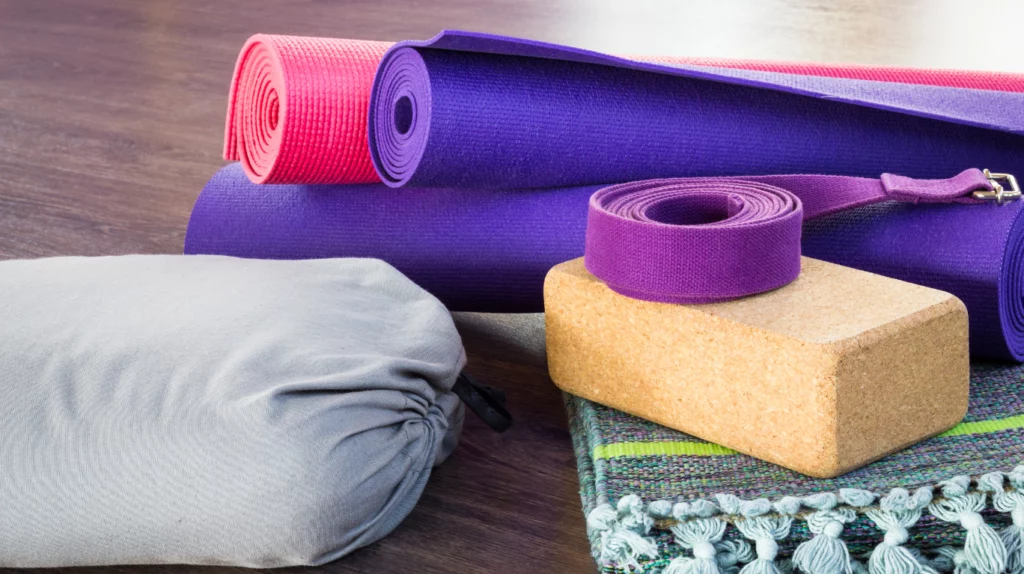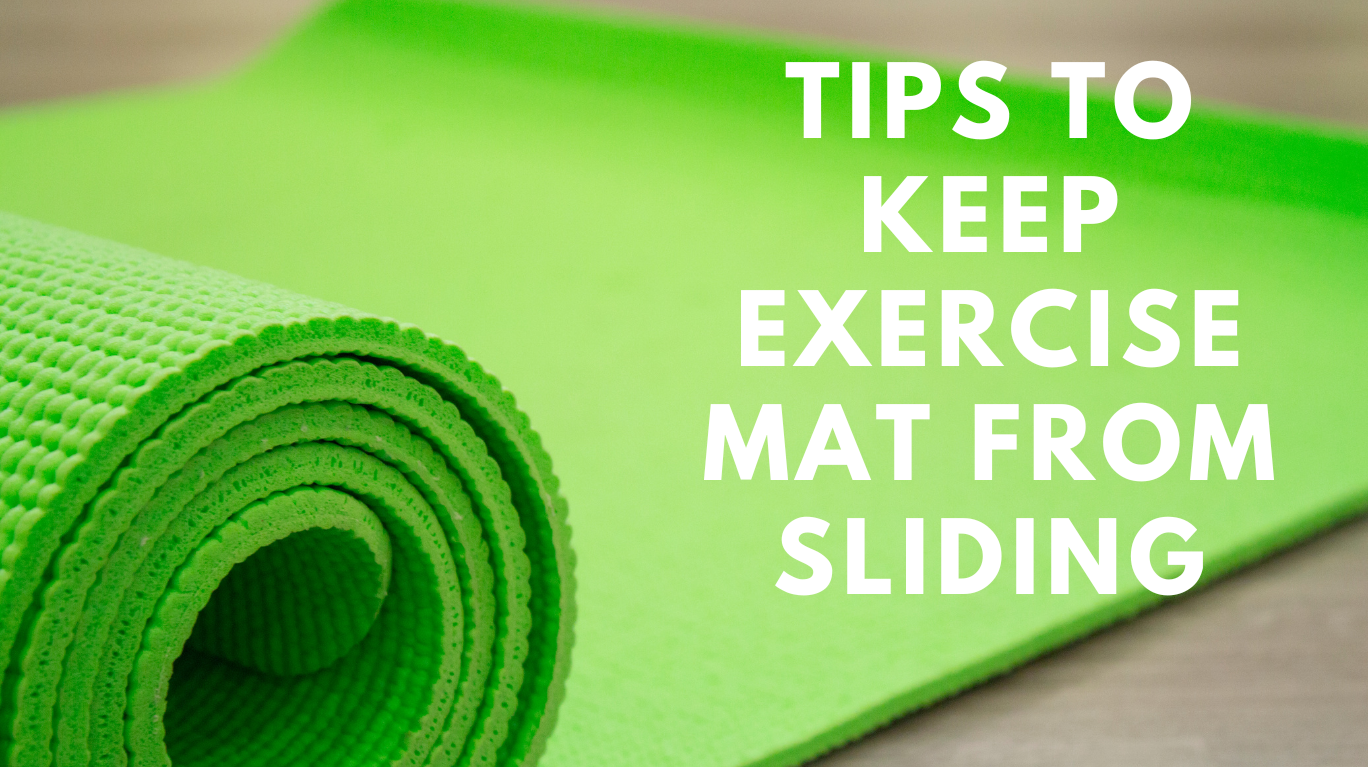Have you ever been in the middle of a yoga session or an intense workout, only to find your exercise mat slipping and sliding beneath you? It’s frustrating, isn’t it? Not only does it disrupt your focus, but it can also be downright dangerous.
But fret not! We have simple yet effective tricks up our sleeves that will keep your mat under your feet. Say goodbye to those distracting mat movements and hello to uninterrupted workouts!
So, let’s dive into how to keep exercise mat from sliding and ensure a smoother and safer workout experience.
Causes of Exercise Mat Sliding
Exercise mats can slide due to various reasons such as sweat, dust, and dirt buildup on the mat, moisture from sweaty palms and feet, and the type of surface the mat is placed on. Let us explain!
-
Sweat, Dust, and Dirt Buildup
One major cause is the buildup of sweat, dust, and dirt on the mat’s surface. This can reduce its grip on the floor, causing it to slide. Gradually these particles accumulate, creating a slippery layer that weakens the mat’s stability.
-
Moisture
Moisture, particularly from sweaty palms and feet, contributes to the sliding issue. When the mat becomes wet, its traction decreases, making it more prone to movement. The moisture acts as a barrier between the mat and the floor, reducing the friction that keeps the mat in place.
-
Surface Type
Lastly, the type of surface the mat is placed on matters. Mats tend to slide more on smooth floors like hardwood or tile, compared to carpeted surfaces that provide more grip.
How to Keep Exercise Mat from Sliding: Practical Tips
Does your exercise mat keep sliding around while you work out? No worries! Here are some easy and practical tips to keep your exercise mat in place:

-
Regular Cleaning
A clean mat is less likely to slip. Wipe it down with a damp cloth regularly to remove any sweat or dirt that might make it slippery.
-
Use Non-slip Rug Pads
Placing a non-slip rug pad underneath your exercise mat can help keep it stable on the floor. These pads provide extra grip and prevent your mat from moving around.
-
Try Yoga Towels for Added Grip
Lay a yoga towel over your mat before you start your workout. These towels absorb moisture and provide extra traction, especially during sweaty workouts. The towel’s texture will also create more friction, making it less likely for your mat to slide.
-
Consider Thin Yoga Mats
Thinner mats tend to have better traction. They provide a more stable surface and are less likely to slide on the floor.
-
The Cutting Board Trick
If you’re working out on a smooth surface, place a small, clean cutting board under each corner of your mat. This will help anchor the mat and stop it from moving.
-
Double-Sided Tape
Secure the corners of your mat to the floor using double-sided tape. This is especially helpful if you’re doing high-intensity exercises. Make sure it’s easy to remove without damaging your mat or the floor.
-
Choose the Right Surface
Exercise on a surface that offers good traction, like carpeting or rubber flooring. Avoid hardwood or tile floors that might make your mat slide more.
-
Consider Yoga Socks or Non-slip Shoes
Consider wearing yoga socks or shoes with non-slip soles. These can provide you with extra grip and stability during your workouts.
-
Hook-and-Loop Fasteners
Attach hook-and-loop fasteners like Velcro to the corners of your mat and the floor. This can help hold the mat securely in place.
-
Silicone or Rubber Mat Grips
Look for silicone or rubber mat grips that you can place underneath your mat. These grips grip onto the floor and keep your mat from slipping.
By following these effective tips, you can improve the grip and stability of your exercise mat, ensuring a safer and more comfortable workout experience.
DIY Solutions to Prevent Exercise Mats from Sliding
Exercise mats slipping around can be annoying and unsafe during workouts. Here are some DIY solutions for exercise mat stability:
-
Install No-skid Rug Backing
When it comes to keeping your exercise mat in place, a simple solution is to use no-skid rug backing. This backing material prevents rugs and mats from sliding around. Place the no-skid rug backing under your exercise mat, and it will help grip the floor better.
You can find this backing at most home improvement stores, and it’s easy to cut it to fit your mat size. This way, you can exercise with confidence, knowing your mat won’t move.
-
Use Horse Stall Mats
If you’re looking for a sturdy and reliable option, consider using horse stall mats. Horse stall mats are thick and heavy rubber mats that offer excellent grip. They’re durable and often larger than regular exercise mats, covering more floor area.
By placing your exercise mat on top of a horse stall mat, you can create a stable workout surface that stays in place, even during intense exercises.
-
Choose a Textured Mat
Opt for an exercise mat with a textured surface. These mats offer a better grip, which can help prevent slipping. The textured patterns create friction between your mat and the floor, keeping it from moving around while you exercise.
Remember to test the texture to make sure it feels comfortable for your workouts, while still providing the necessary grip.
-
Use Interlocking Floor Mats
Interlocking floor mats are like puzzle pieces that fit together. They’re great for creating a larger exercise area and preventing individual mats from sliding. These mats lock into each other, creating a stable and secure surface for your workouts.
You can find interlocking floor mats in various thicknesses and materials. So choose the ones that suit your exercise needs best.
-
Attach Mats Together
If you have many exercise mats, consider attaching them together to prevent sliding. You can use strong double-sided tape or hook-and-loop fasteners to secure the edges of the mats. This prevents individual mats from moving and keeps them in place.
Make sure the attachment method you choose doesn’t damage your mats or the floor.
By using one or more of these DIY solutions, you can keep your exercise mat stable and prevent it from sliding during your workouts.
Conclusion
Incorporating these practical solutions into your workout routine can make a world of difference in maintaining a slip-free exercise mat. Remember, a slip-free mat is not just about convenience, but also about your safety and the effectiveness of your workouts. Now that you know how to keep your exercise mat from sliding, it’s time to take action. Give these methods a try and experience the benefits firsthand. Enjoy your workouts with confidence, knowing that your stable mat will support you every step of the way.
Common Queries
What materials work well for non-slip exercise mats?
The best materials for non-slip exercise mats often include natural rubber or TPE. These materials offer excellent grip and stability during workouts.
What should be placed beneath an exercise mat for grip?
Place a rug pad or grip-enhancing mat underneath your exercise mat. This adds extra cushion and prevents your exercise mat from moving around.
What are effective methods to prevent an exercise mat from moving on the floor?
To prevent your exercise mat from sliding on the floor, ensure the floor surface is clean and dry. Consider using double-sided tape designed for mats, or opt for mats with integrated non-slip features.
How can I ensure my mat doesn’t slide on a carpeted surface?
To prevent your mat from slipping on the carpet, consider using a non-slip rug pad underneath. These pads provide grip and stability, keeping your mat in place during use.
How can I select a suitable non-slip rug pad size for my exercise mat?
When selecting a non-slip rug pad for an exercise mat, choose a pad that’s slightly smaller than the mat itself. This ensures the pad doesn’t extend beyond the edges of the mat, providing an effective grip without causing any inconvenience during your workout.

